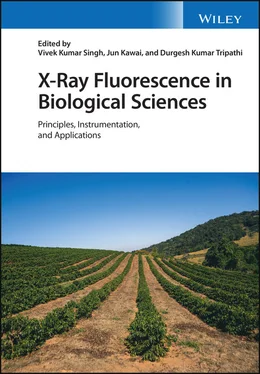X-Ray Fluorescence in Biological Sciences
Здесь есть возможность читать онлайн «X-Ray Fluorescence in Biological Sciences» — ознакомительный отрывок электронной книги совершенно бесплатно, а после прочтения отрывка купить полную версию. В некоторых случаях можно слушать аудио, скачать через торрент в формате fb2 и присутствует краткое содержание. Жанр: unrecognised, на английском языке. Описание произведения, (предисловие) а так же отзывы посетителей доступны на портале библиотеки ЛибКат.
- Название:X-Ray Fluorescence in Biological Sciences
- Автор:
- Жанр:
- Год:неизвестен
- ISBN:нет данных
- Рейтинг книги:5 / 5. Голосов: 1
-
Избранное:Добавить в избранное
- Отзывы:
-
Ваша оценка:
- 100
- 1
- 2
- 3
- 4
- 5
X-Ray Fluorescence in Biological Sciences: краткое содержание, описание и аннотация
Предлагаем к чтению аннотацию, описание, краткое содержание или предисловие (зависит от того, что написал сам автор книги «X-Ray Fluorescence in Biological Sciences»). Если вы не нашли необходимую информацию о книге — напишите в комментариях, мы постараемся отыскать её.
Discover a comprehensive exploration of X-ray fluorescence in chemical biology and the clinical and plant sciences X-Ray Fluorescence in Biological Sciences: Principles, Instrumentation, and Applications
X-Ray Fluorescence in Biological Sciences: Principles, Instrumentation, and Applications
X-Ray Fluorescence in Biological Sciences — читать онлайн ознакомительный отрывок
Ниже представлен текст книги, разбитый по страницам. Система сохранения места последней прочитанной страницы, позволяет с удобством читать онлайн бесплатно книгу «X-Ray Fluorescence in Biological Sciences», без необходимости каждый раз заново искать на чём Вы остановились. Поставьте закладку, и сможете в любой момент перейти на страницу, на которой закончили чтение.
Интервал:
Закладка:
Based on the studies carried out, the authors drew the following conclusions:
XRF proved an effective method for measuring the concentrations of a suite of 13 elements in tea.
The concentration of elements in tea samples could serve as a basis for determining the origin of samples even for closely spaced areas.
Dalipi et al. [80] used a desktop spectrometer S2 PICOFOX (Bruker AXS, Germany). 40 commercially available samples of tea, herbs, and roots were analyzed. Solid samples were ground in an agate mortar. Microwave decomposition was then applied followed by treatment with a mixture of nitric acid and hydrogen peroxide (six minutes). Ga (1 mg/l in the liquid sample prepared for analysis) was used as an internal standard. The contents of 13 elements K, Ca, Ti, Cr, Mn, Fe, Ni, Cu, Zn, Rb, Sr, Ba, and Pb in the test samples were determined. Chemometry was used for classification purposes. The findings showed that TXRF is a fast and simple method of controlling the quality of tea and grass samples, and it can be used on a regular basis in addition to other traditional spectroscopy techniques.
Table 3.1shows the results of determining the concentrations of several elements in tea samples obtained by examining tea of different origins with XRF. The ranges of their change are significant narrow than range for rocks. Nevertheless, the question of inter‐elemental effects on the results of the determination of chemical composition seems relevant and important in the study of tea and coffee samples.
Table 3.1 Contents of some elements in the samples of tea (ppm) of different origins, obtained by XRF.
| References | [65] | [79] | [63, 64] | [69] | [70] | [80] | |||
|---|---|---|---|---|---|---|---|---|---|
| Tea | Black | Black | Black | Black | Green | Black | Black | Green | |
| Ti | — a | – | – | – | 4–70 | 15–52 | n/d b–10 | 3–30 | 2–19 |
| Cr | – | – | <2–3.4 | <2–4.7 | – | – | n/d–0.26 | n/d–4.6 | 0.8–10 |
| Mn | – | 43–724 | 213–1228 | 28–730 | 160–1500 | 548–1500 | — | 162–1000 | 174–1130 |
| Fe | 1600–12 200 | 14–234 | 99–617 | 144–993 | 50–1800 | 18–752 | 0.2–107 | 79–1140 | 63–1040 |
| Co | — | — | <1–1.3 | <1 | — | — | н/о–0.12 | — | — |
| Ni | — | — | 1.2–8.1 | 1.4–4.3 | 2–23 | 5.1–8.9 | 0.06–3.2 | 1–5.3 | 2.7–13 |
| Cu | 100–250 | 12–27 | 15.4–30.2 | 4.6–12 | 8–40 | 13–20 | 0.2–2.7 | 10–56 | 10–17.6 |
| Zn | 130–280 | 20–149 | 20–85 | 15–37 | 20–60 | 30–54 | н/о‐4.5 | 25–450 | 29–61 |
| Rb | 50–190 | 11–129 | 2.6–71 | 2.7–38.2 | 25–150 | 82–130 | — | 23–95 | 14–73 |
| Sr | 20–90 | 2–18 | 12–38 | 3.9–17.6 | 3.5–24 | 8.4–15 | — | 9–45 | 2.6–35 |
| Pb | 20–100 | 0.5–4.3 | 0.4–2.3 | 0.3–8.3 | 0.9–4 | — | 0.5–1.8 | 0.8–3.1 |
a‐ Not determined.
b‐ n/d: not detected.
Our estimates of this factor, presented in the last section of this chapter, have shown its significance.
There is no denying the fact that tea is the most popular drink in the world, along with water, and therefore it can be recognized as an important part of a healthy diet. However, it can be seen from this literature review that tea consumption may also lead to oral consumption of various trace elements, as tea plants have the genetic potential to absorb non‐essential trace elements. The content of trace elements in all the analyzed tea samples discussed in this section as well as in the overview Karak et al. [30], was within safe limits for human consumption. The results demonstrated that tea still provides a significant share of human needs for trace elements. However, as of the present day, the adverse effects of tea on human health associated with individual trace elements have not been clarified.
3.5 Examples of Practical Applications of XRF for Coffee Research
Coffee processing begins with green coffee grains undergoing a thermal procedure (roasting). As a result, fried coffee grains are produced. The composition of green coffee grains depends on several factors such as variety, origin, climate, soil quality, treatment on fields, and collection and storage procedures. During the roasting process, the beans undergo physical changes and go through several chemical reactions that alter, generate, and decompose the coffee aroma. It is noted that the chemical composition of fried coffee beans plays an important role in determining the quality of the coffee drink [81]. The quality of beans depends on the species, geographical origin, content of defective beans, and other substances added (accidentally or intentionally), i.e. coffee husks and stems, corn, barley, chicory, wheat middlings, brown sugar, soybean, rye, etc. [25].
Orlic et al. [82] published one of the first papers on the use of XRF to research of samples of coffee. Let's review their results. The authors used the X‐ray spectrometer PW 1010/30 from Philips with X‐ray tube with Mo‐anode, and two modes of a fluorescence excitation: direct and secondary excitation mode (Zr, Mo, and Ag pure foils). Coffee grains were air dried at 85 °C for 24 hours, then ground in an agate mortar manually or mechanically. Coffee powder was placed in Teflon holders or pressed into tablets. The results of analysis of some coffee products (grains, pulp and cascarilla) are shown in Table 3.2. Thirteen elements were found in the concentration range from 0.2 ppm to 1.56%. The K concentration in grains is higher than in pulp (~1.5 and 1%, respectively) and significantly lower in cascarilla (0.07%). A typical Ca concentration is 0.15% in grains, 0.5% in pulp and 0.06% in cascarilla. Elements other than Zn and Fe show no significant changes in concentrations. The Zn content is generally higher in pulp (60–70 ppm) than in grains and cascarilla. Fe concentrations vary from 50 to 92 ppm (in the text for some reason up to 1300 ppm) in various grain samples, while Cu concentrations range are from 15 to 20 ppm. It is obtained that the As content is in the range of concentrations between 0.2 to 10 ppm and Pb is about 1 ppm. In some pulp samples, extremely high (~180 ppm) concentrations of Pb were found, but these coffee trees were treated with insecticides for experimental purposes. Concentrations of As and Pb, elements which are of interest were close to their minimum detection limits in some samples, and therefore the results obtained for these elements should be taken with caution. For these cases, the authors pre‐tested two methods of concentration: chemical decomposition followed by precipitation and low temperature ashing. The first method gives particularly good results for all non‐volatile elements such as Fe, Ni, Cu, Zn, Cd, Hg, and Pb. On the other hand, low temperature ashing can be effectively used for both high Z metals and volatile elements, among which As is the most important in coffee analysis.
Table 3.2 Concentrations of elements in some coffee products (ppm).
| Element | Sample | ||||
|---|---|---|---|---|---|
| Grain 1 | Grain 2 | Grain 3 | Pulp | Cascarilla | |
| K | 15 645 | 15 304 | 14 700 | 10 370 | 725 |
| Ca | 1482 | 1372 | 1514 | 5390 | 621 |
| Ti | — | — | 1.2 | 11 | — |
| Mn | 38 | 36 | 22 | 30 | 11 |
| Fe | 54 | 54 | 92 | 45 | 70 |
| Ni | 0.3 | 0.5 | — | 0.3 | 0.6 |
| Cu | 18 | 17 | 18 | 27 | 22 |
| Zn | 5.8 | 5.9 | 10 | 57 | 6 |
| As | — | 0.2 | 1.2 | — | 0.6 |
| Se | — | 0.2 | 0.4 | — | 0.1 |
| Br | 1.1 | 1.0 | 1.2 | 1.4 | 1.9 |
| Rb | 39 | 40 | 38 | — | 3.3 |
| Pb | — | 0.9 | 0.3 | 17.2 | — |
Haswell et al. [11] discusses the use of the EXTRA II TXRF spectrometer (Germany) for the classification of coffee and wine. In the first step of analysis preparation, the purified quartz reflectors were scanned to check for contamination. The quartz glass reflectors were processed with silicone solution (to prevent wetting on the disc and to aid droplet formation). For the analysis, samples of Cabernet Sauvignon wine from different countries and instant coffee of several brands were used. In preparing the specimens, a solution containing element V (internal standard) and deionized water was added to the wine and coffee samples. An aliquot of the sample with the added internal standard was then pipetted onto the prepared reflector. Measurements for each sample were performed for five hundred seconds, six times. Relative standard deviation for Ni turned out to be more (10 to 50%) than for other elements – K, Ca, Cr, Mn, Fe, Cu, Zn, Br, Rb, and Sr (up to 10%). Based on the results of the determination petal diagrams and dendrograms were built that showed a unique shape depending on chemical composition. The proposed technique allowed researchers to accurately determine the country of wine production and the brand of coffee.
Читать дальшеИнтервал:
Закладка:
Похожие книги на «X-Ray Fluorescence in Biological Sciences»
Представляем Вашему вниманию похожие книги на «X-Ray Fluorescence in Biological Sciences» списком для выбора. Мы отобрали схожую по названию и смыслу литературу в надежде предоставить читателям больше вариантов отыскать новые, интересные, ещё непрочитанные произведения.
Обсуждение, отзывы о книге «X-Ray Fluorescence in Biological Sciences» и просто собственные мнения читателей. Оставьте ваши комментарии, напишите, что Вы думаете о произведении, его смысле или главных героях. Укажите что конкретно понравилось, а что нет, и почему Вы так считаете.











